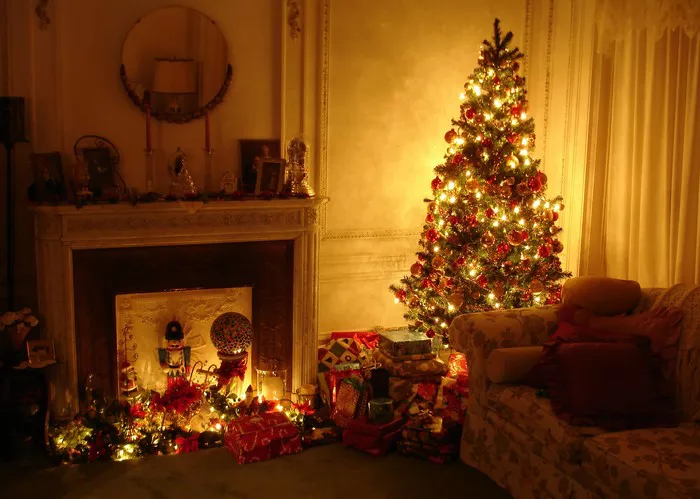The Christmas tree, a central symbol of Christmas festivities, has roots that extend far beyond Christian traditions. Its origins can be traced back to ancient pagan practices and beliefs. This article explores the historical and symbolic significance of the Christmas tree in paganism, examining how it was incorporated into modern Christmas celebrations and what it represented in the context of pre-Christian cultures.
Historical Roots of the Christmas Tree in Paganism
Ancient Celebrations and the Evergreen Tree
Long before the advent of Christianity, evergreen trees held a significant place in various pagan cultures. These trees, which remained green and vibrant throughout the harsh winter months, were seen as symbols of life, renewal, and resilience. They were often associated with celebrations and rituals designed to honor the natural world and its cycles.
One of the most notable pagan festivals was Yule, celebrated by the Norse and Germanic tribes around the winter solstice. This period, marking the shortest day and longest night of the year, was a time of great importance. The evergreen tree, with its unyielding green needles, symbolized the promise of the return of sunlight and the rejuvenation of nature. As part of the Yule celebrations, people would bring evergreen boughs into their homes to remind them of the coming spring.
Symbolism of the Evergreen Tree in Pagan Beliefs
Symbol of Eternal Life
In many pagan traditions, the evergreen tree was a powerful symbol of eternal life. Unlike deciduous trees that shed their leaves and appear lifeless during winter, evergreens maintain their foliage year-round. This characteristic made them a symbol of immortality and a reminder that life persists even in the darkest and coldest of times. This symbolism was particularly resonant during the winter solstice, a time when the sun’s return was eagerly anticipated.
Tree Worship and Spiritual Significance
Trees held a sacred place in many pagan religions. They were often seen as dwelling places for spirits and deities, and certain trees were considered especially holy. The practice of tree worship can be found in various cultures, from the Druids of ancient Britain to the Norse mythology of Yggdrasil, the World Tree. In these traditions, trees were seen as bridges between the earthly realm and the spiritual world, connecting humans to the divine.
The evergreen tree, with its year-round vitality, was particularly revered. It was believed to embody the essence of nature’s endurance and was often used in rituals to invoke protection, fertility, and prosperity. The tree’s ability to remain lush and green throughout the year made it a powerful symbol of life’s continuity and the cyclical nature of the seasons.
Evolution of the Christmas Tree Tradition
Adoption by Christianity
As Christianity spread throughout Europe, it encountered deeply rooted pagan customs and traditions. In an effort to facilitate conversion and assimilation, many pagan practices were incorporated into Christian celebrations. The winter solstice festival, with its emphasis on the return of light, was naturally aligned with the Christian celebration of the birth of Jesus Christ, the “light of the world.”
The Christmas tree, with its pagan origins, was gradually integrated into Christian holiday traditions. While the precise timeline of this integration is debated, it is widely accepted that by the 16th century, the Christmas tree had become a common feature of Christmas celebrations in Germany. The practice eventually spread to other parts of Europe and, later, to the United States.
Modern Christmas Tree Traditions
Today’s Christmas tree, adorned with lights, ornaments, and tinsel, is a far cry from the simple evergreen boughs used in ancient pagan rituals. However, many elements of its decoration still echo its pagan roots. For instance, the use of lights and candles harks back to the practice of using fire to symbolize the sun’s return and to ward off the darkness of winter.
Ornaments, often depicting stars, suns, and other natural symbols, can be traced back to pagan traditions of adorning trees with offerings to the gods. Even the star or angel placed atop the tree has parallels in pagan practices of placing sacred objects on trees to honor deities.
The Symbolic Continuity of the Christmas Tree
Resilience and Renewal
At its core, the Christmas tree continues to symbolize resilience and renewal. Its evergreen nature is a reminder of life’s enduring strength and the promise of new beginnings. This symbolism resonates deeply with both its pagan origins and its place in modern Christmas celebrations.
SEE ALSO: What Is the Meaning of Decorating a Christmas Tree
Connection to Nature
The Christmas tree also maintains its role as a symbol of humanity’s connection to the natural world. In an era when many people feel increasingly disconnected from nature, the tree serves as a tangible reminder of the beauty and power of the natural cycles. Decorating a Christmas tree can be seen as an act of honoring nature and acknowledging our place within its rhythms.
Cultural Integration and Adaptation
The evolution of the Christmas tree from a pagan symbol to a central feature of Christian celebrations illustrates the fluidity of cultural practices and beliefs. It highlights how traditions can adapt and merge over time, creating rich and multifaceted cultural symbols. The Christmas tree, in its various forms and meanings, serves as a testament to the enduring human need to find symbols that connect us to the divine, the natural world, and each other.
Conclusion
The Christmas tree’s origins in paganism reveal a deep and ancient connection to nature, resilience, and renewal. From its roots in pre-Christian winter solstice celebrations to its modern incarnation as a beloved symbol of Christmas, the evergreen tree has carried with it powerful symbolism and spiritual significance. Understanding the pagan roots of the Christmas tree enriches our appreciation of this enduring holiday tradition, reminding us of the timeless human desire to find light in the darkness and to celebrate the enduring power of life.
Related Topics:
























